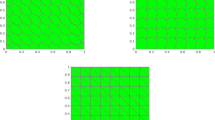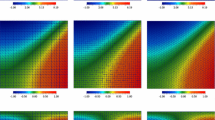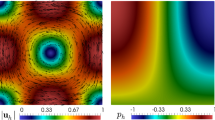Abstract
In this paper we introduce and analyze a new mixed finite element method for the two-dimensional Brinkman model of porous media flow with mixed boundary conditions. We use a dual-mixed formulation in which the main unknown is given by the pseudostress. The original velocity and pressure unknowns are easily recovered through a simple postprocessing. In addition, since the Neumann boundary condition becomes essential, we impose it in a weak sense, which yields the introduction of the trace of the fluid velocity over the Neumann boundary as the associated Lagrange multiplier. We apply the Babuška–Brezzi theory to establish sufficient conditions for the well-posedness of the resulting continuous and discrete formulations. In particular, a feasible choice of finite element subspaces is given by Raviart–Thomas elements of order \(k \ge 0\) for the pseudostress, and continuous piecewise polynomials of degree \(k + 1\) for the Lagrange multiplier. We also derive a reliable and efficient residual-based a posteriori error estimator for this problem. Suitable auxiliary problems, the continuous inf-sup conditions satisfied by the bilinear forms involved, a discrete Helmholtz decomposition, and the local approximation properties of the Raviart–Thomas and Clément interpolation operators are the main tools for proving the reliability. Then, Helmholtz’s decomposition, inverse inequalities, and the localization technique based on triangle-bubble and edge-bubble functions are employed to show the efficiency. Finally, several numerical results illustrating the performance and the robustness of the method, confirming the theoretical properties of the estimator, and showing the behaviour of the associated adaptive algorithm, are provided.








Similar content being viewed by others
References
Agmon, S.: Lectures on Elliptic Boundary Value Problems. Van Nostrand, Princeton (1965)
Arnold, D.N.: An interior penalty finite element method with discontinuous elements. SIAM J. Numer. Anal. 19(4), 742–760 (1982)
Arnold, D.N., Brezzi, F., Douglas, J.: PEERS: a new mixed finite element method for plane elasticity. Jpn. J. Appl. Math. 1, 347–367 (1984)
Arnold, D.N., Douglas, J., Gupta, ChP: A family of higher order mixed finite element methods for plane elasticity. Numer. Math. 45(1), 1–22 (1984)
Babuška, I., Aziz, A.K.: Survey lectures on the mathematical foundations of the finite element method. In: Aziz, A.K. (ed.) The Mathematical Foundations of the Finite Element Method with Applications to Partial Differential Equations. Academic Press, New York (1972)
Babuška, I., Gatica, G.N.: On the mixed finite element method with Lagrange multipliers. Numer. Methods Partial Differ. Equ. 19(2), 192–210 (2003)
Barrios, T.P., Gatica, G.N., González, M., Heuer, N.: A residual based a posteriori error estimator for an augmented mixed finite element method in linear elasticity. ESAIM Math. Model. Numer. Anal. 40(5), 843–869 (2006)
Brezzi, F., Fortin, M.: Mixed and Hybrid Finite Element Methods. Springer, Berlin (1991)
Burman, E., Hansbo, P.: A unified stabilized method for Stokes’ and Darcy’s equations. J. Comput. Appl. Math. 198(1), 35–51 (2007)
Cai, Z., Lee, B., Wang, P.: Least-squares methods for incompressible Newtonian fluid flow: linear stationary problems. SIAM J. Numer. Anal. 42(2), 843–859 (2004)
Cai, Z., Starke, G.: Least-squares methods for linear elasticity. SIAM J. Numer. Anal. 42(2), 826–842 (2004)
Cai, Z., Tong, Ch., Vassilevski, P.S., Wang, Ch.: Mixed finite element methods for incompressible flow: stationary Stokes equations. Numer Methods Partial Differ. Equ. 26(4), 957–978 (2009)
Carstensen, C.: An a posteriori error estimate for a first-kind integral equation. Math. Comput. 66(217), 139–155 (1997)
Carstensen, C.: A posteriori error estimate for the mixed finite element method. Math. Comput. 66(218), 465–478 (1997)
Carstensen, C., Dolzmann, G.: A posteriori error estimates for mixed FEM in elasticity. Numer. Math. 81(2), 187–209 (1998)
Ciarlet, P.G.: The Finite Element Method for Elliptic Problems. North-Holland, Amsterdam (1978)
Clément, P.: Approximation by finite element functions using local regularisation. RAIRO Model. Math. et Anal. Numer. 9, 77–84 (1975)
Ervin, V.J., Howell, J.S., Stanculescu, I.: A dual-mixed approximation method for a three-field model of a nonlinear generalized Stokes problem. Comput. Methods Appl. Mech. Eng. 197(33–40), 2886–2900 (2008)
Figueroa, L., Gatica, G.N., Heuer, N.: A priori and a posteriori error analysis of an augmented mixed finite element method for incompressible fluid flows. Comput. Methods Appl. Mech. Eng. 198(2), 280–291 (2008)
Figueroa, L.E., Gatica, G.N., Márquez, A.: Augmented mixed finite element methods for the stationary Stokes Equations. SIAM J. Sci. Comput. 31(2), 1082–1119 (2008)
Gatica, G.N.: A note on the efficiency of residual-based a-posteriori error estimators for some mixed finite element methods. Electron. Trans. Numer. Anal. 17, 218–233 (2004)
Gatica, G.N.: Analysis of a new augmented mixed finite element method for linear elasticity allowing \(\mathbb{RT}_0-\mathbb{P}_1-\mathbb{P}_0\) approximations. ESAIM Math. Model. Numer. Anal. 40(1), 1–28 (2006)
Gatica, G.N., González, M., Meddahi, S.: A low-order mixed finite element method for a class of quasi-Newtonian Stokes flows. I: a priori error analysis. Comput. Methods Appl. Mech. Eng. 193(9–11), 881–892 (2004)
Gatica, G.N., Hsiao, G., Meddahi, S.: A residual-based a posteriori error estimator for a two-dimensional fluid–solid interaction problem. Numer. Math. 114(1), 63–106 (2009)
Gatica, G.N., Márquez, A., Meddahi, S.: An augmented mixed finite element method for 3D linear elasticity problems. J. Comput. Appl. Math. 231(2), 526–540 (2009)
Gatica, G.N., Márquez, A., Sánchez, M.: Analysis of a velocity–pressure–pseudostress formulation for the stationary Stokes equations. Comput. Methods Appl. Mech. Eng. 199(17–20), 1064–1079 (2010)
Gatica, G.N., Márquez, A., Sánchez, M.: A priori and a posteriori error analyses of a velocity–pseudostress formulation for a class of quasi-Newtonian Stokes flows. Comput. Methods Appl. Mech. Eng. 200(17–20), 1619–1636 (2011)
Gatica, G.N., Oyarzúa, R., Sayas, F.J.: Analysis of fully-mixed finite element methods for the Stokes–Darcy coupled problem. Math. Comput. 80(276), 1911–1948 (2011)
Girault, V., Raviart, P.A.: Finite element methods for Navier–Stokes equations. In: Theory and Algorithms. Springer, Berlin (1986)
Hansbo, P., Juntunen, M.: Weakly imposed Dirichlet boundary conditions for the Brinkman model of porous media flow. Appl. Numer. Math. 59(6), 1274–1289 (2009)
Hiptmair, R.: Finite elements in computational electromagnetism. Acta Numer. 11, 237–339 (2002)
Howell, J.S.: Dual-mixed finite element approximation of Stokes and nonlinear Stokes problems using trace-free velocity gradients. J. Comput. Appl. Math. 231(2), 780–792 (2009)
Juntunen, M., Stenberg, R.: Analysis of finite element methods for the Brinkman problem. Calcolo 47(3), 129–147 (2010)
Lions, J.-L., Magenes, E.: Problèmes aux Limites non Homogènes et Applications I. Dunod, Paris (1968)
Mc Lean, W.: Strongly Elliptic Systems and Boundary Integral Equations. Cambridge University Press, London (2000)
Márquez, A., Meddahi, S., Sayas, F.-J.: Strong coupling of finite element methods for the Stokes–Darcy problem. arXiv:1203.4717v1[math.NA]
Nečas, J.: Les Méthodes Directes en Théorie des Équations Elliptiques. Masson, Paris (1967)
Prössdorf, S., Silbermann, B.: Numerical Analysis for Integral and Related Operator Equations. Birkhäuser, Basel (1991)
Quarteroni, A., Valli, A.: Numerical Approximation of Partial Differential Equations. Springer, Heidelberg (1996)
Roberts, J.E., Thomas, J.M.: Mixed and hybrid methods. In: Ciarlet, P.G., Lions, J.L. (eds.) Handbook of Numerical Analysis. Finite Element Methods (Part 1), vol. II. Nort-Holland, Amsterdam (1991)
Verfürth, R.: A posteriori error estimation and adaptive-mesh-refinement techniques. J. Comput. Appl. Math. 50(1–3), 67–83 (1994)
Verfürth, R.: A Review of A Posteriori Error Estimation and Adaptive-Mesh-Refinement Techniques. Wiley, Chichester (1996)
Author information
Authors and Affiliations
Corresponding author
Additional information
This research was partially supported by BASAL project CMM, Universidad de Chile, by Centro de Investigación en Ingeniería Matemática (CI\(^2\)MA), Universidad de Concepción, by CONICYT-Chile through project Anillo ACT1118 (ANANUM) and the Fondecyt project 1080392, and by Dirección de Investigación, Universidad Católica de la Santísima Concepción.
Rights and permissions
About this article
Cite this article
Gatica, G.N., Gatica, L.F. & Márquez, A. Analysis of a pseudostress-based mixed finite element method for the Brinkman model of porous media flow. Numer. Math. 126, 635–677 (2014). https://doi.org/10.1007/s00211-013-0577-x
Received:
Revised:
Published:
Issue Date:
DOI: https://doi.org/10.1007/s00211-013-0577-x




